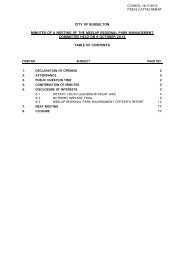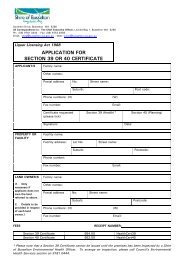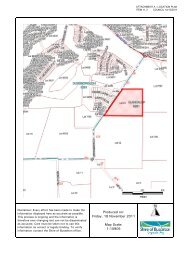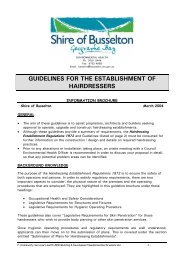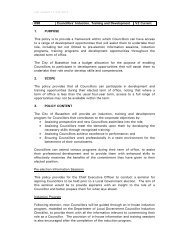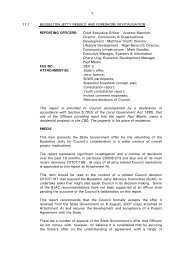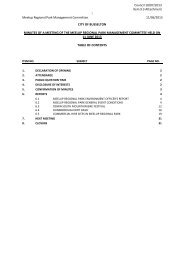Draft Guidelines for the Reuse of Greywater in Western Australia
Draft Guidelines for the Reuse of Greywater in Western Australia
Draft Guidelines for the Reuse of Greywater in Western Australia
You also want an ePaper? Increase the reach of your titles
YUMPU automatically turns print PDFs into web optimized ePapers that Google loves.
3. ENVIRONMENTAL IMPACT CONSIDERATIONS<br />
DRAFT<br />
Domestic reuse <strong>of</strong> greywater will help <strong>the</strong> environment by reduc<strong>in</strong>g demand on higher<br />
quality bore and scheme waters. However, greywater reuse is only part <strong>of</strong> <strong>the</strong> approach<br />
we need to adopt to protect our water resources. To conserve ground and surface water<br />
resources, even be<strong>for</strong>e consider<strong>in</strong>g greywater reuse, it is essential that water conservation<br />
is practiced. <strong>Greywater</strong> generation should be m<strong>in</strong>imised <strong>for</strong> three important reasons:<br />
● to conserve dr<strong>in</strong>k<strong>in</strong>g water as a precious natural resource;<br />
● to ensure that greywater does not overload <strong>the</strong> <strong>in</strong>stalled greywater land application<br />
system; and<br />
● to m<strong>in</strong>imise land requirements <strong>for</strong> a greywater reuse system.<br />
Various water sav<strong>in</strong>g devices can be used to conserve water, <strong>in</strong>clud<strong>in</strong>g dual flush toilet<br />
cisterns and reduced flow shower heads, dishwashers and wash<strong>in</strong>g mach<strong>in</strong>es. Water may<br />
also be conserved us<strong>in</strong>g a range <strong>of</strong> practices such as shorter showers, turn<strong>in</strong>g <strong>the</strong> tap <strong>of</strong>f<br />
when clean<strong>in</strong>g teeth, ensur<strong>in</strong>g that taps do not cont<strong>in</strong>uously drip, and us<strong>in</strong>g dishwashers<br />
and clo<strong>the</strong>s washers only when <strong>the</strong> load is full. As 47% <strong>of</strong> household water usage is <strong>for</strong><br />
garden water<strong>in</strong>g, a water wise garden can greatly reduce water usage. For more<br />
<strong>in</strong><strong>for</strong>mation on ways to save water <strong>in</strong> <strong>the</strong> home contact <strong>the</strong> Water Corporation.<br />
The Government has committed significant funds to provide <strong>in</strong>fill sewerage to many<br />
unsewered urban areas <strong>in</strong> <strong>Western</strong> <strong>Australia</strong>. This occurred <strong>for</strong> a number <strong>of</strong> reasons<br />
<strong>in</strong>clud<strong>in</strong>g environmental concerns about nutrient impacts from septic tank systems. It<br />
would <strong>the</strong>re<strong>for</strong>e be irresponsible to divert greywater from <strong>the</strong> sewer <strong>for</strong> reuse onsite <strong>in</strong><br />
locations where phosphates from greywater could negatively impact on nearby<br />
environmentally sensitive water bodies without suitable protective measures be<strong>in</strong>g<br />
implemented.<br />
To m<strong>in</strong>imise negative impacts on <strong>the</strong> environment from greywater reuse, <strong>the</strong> follow<strong>in</strong>g<br />
requirements apply:<br />
3.1 <strong>Greywater</strong> must be conta<strong>in</strong>ed with<strong>in</strong> <strong>the</strong> conf<strong>in</strong>es <strong>of</strong> <strong>the</strong> premises on which it is<br />
generated and not be permitted to run<strong>of</strong>f onto neighbour<strong>in</strong>g properties.<br />
3.2 Only products with very low phosphorus content should be used. Phosphorus<br />
content can range from a low content <strong>of</strong> 0.05% up to 10% <strong>in</strong> various detergents.<br />
Native plants (not all) are sensitive to additional phosphorus. Plants <strong>of</strong> <strong>the</strong><br />
Proteaceae family (such as grevillea, hakea, banksia and silky oak) are susceptible<br />
to excess phosphates. These plants are not ideally suited to greywater reuse.<br />
3.3 <strong>Greywater</strong> tends to be slightly alkal<strong>in</strong>e, with a pH range <strong>of</strong> typically between 6.5 and<br />
9.0, and <strong>the</strong> extensive use <strong>of</strong> greywater <strong>for</strong> irrigation could cause <strong>the</strong> soil to become<br />
progressively more alkal<strong>in</strong>e. Shade lov<strong>in</strong>g and acid lov<strong>in</strong>g plants do not like <strong>the</strong><br />
alkal<strong>in</strong>ity <strong>of</strong> greywater. These <strong>in</strong>clude azaleas, camellias, gardenias, begonias, and<br />
ferns.<br />
6 <strong>Draft</strong> <strong>Guidel<strong>in</strong>es</strong> <strong>for</strong> <strong>the</strong> <strong>Reuse</strong> <strong>of</strong> <strong>Greywater</strong> <strong>in</strong> <strong>Western</strong> <strong>Australia</strong>




